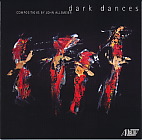
Dark Dances: Compositions by John Allemeier (Albany, 1243)
American Record Guide May/June 2011
The performers really dig into the music on Dark Dances, and it fits the music well. Even at their most tranquil these four pieces by John Allemeier expresses a certain virility, and they are well served here by the players. Those Voices is a compelling piece for flute, bass clarinet, and string trio, juxtaposing the woodwinds with gritty double stops and open strings in the outer sections, contrasting those with more homogeneous middle section. Dark Dances is a set of three pieces for percussion ensemble, combining pitched and non-pitched instruments. Solstice is a piece in three parts for flute, saxophone, violin, cello, and bass written in collaboration with choreographer EE Balcos. It is an evocative piece largely built up of modal material. 4, a four-movement work for piano quartet, alternates monophonic passages with mildly dissonant harmony and includes a five-part fugue in III. Allemeier manages to create lush and interesting sounds without sounding dated, and in all the pieces on the recording his writing is assured and interesting.
Byelick
American Record Guide May/June 2011
The performers really dig into the music on Dark Dances, and it fits the music well. Even at their most tranquil these four pieces by John Allemeier expresses a certain virility, and they are well served here by the players. Those Voices is a compelling piece for flute, bass clarinet, and string trio, juxtaposing the woodwinds with gritty double stops and open strings in the outer sections, contrasting those with more homogeneous middle section. Dark Dances is a set of three pieces for percussion ensemble, combining pitched and non-pitched instruments. Solstice is a piece in three parts for flute, saxophone, violin, cello, and bass written in collaboration with choreographer EE Balcos. It is an evocative piece largely built up of modal material. 4, a four-movement work for piano quartet, alternates monophonic passages with mildly dissonant harmony and includes a five-part fugue in III. Allemeier manages to create lush and interesting sounds without sounding dated, and in all the pieces on the recording his writing is assured and interesting.
Byelick